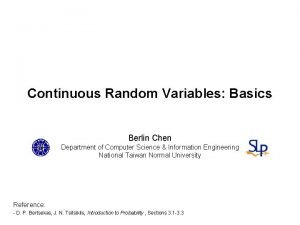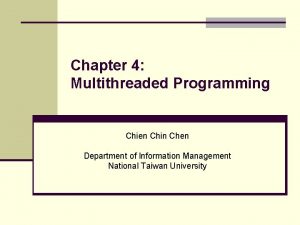Chapter 6 Synchronization Chien Chin Chen Department of














![Peterson’s Solution (2/5) n The Peterson’s solution for process Pi. do { flag[i] = Peterson’s Solution (2/5) n The Peterson’s solution for process Pi. do { flag[i] =](https://slidetodoc.com/presentation_image_h/eaa37eb0466607b3f2d87fc6a7aa7d08/image-15.jpg)








![Synchronization Hardware (6/7) do { waiting[i] = TRUE; key = TRUE; while (waiting[i] && Synchronization Hardware (6/7) do { waiting[i] = TRUE; key = TRUE; while (waiting[i] &&](https://slidetodoc.com/presentation_image_h/eaa37eb0466607b3f2d87fc6a7aa7d08/image-24.jpg)






































![Monitors – Dining-Philosophers Solution (12/18) void pickup (int i) { state[i] = HUNGRY; test(i); Monitors – Dining-Philosophers Solution (12/18) void pickup (int i) { state[i] = HUNGRY; test(i);](https://slidetodoc.com/presentation_image_h/eaa37eb0466607b3f2d87fc6a7aa7d08/image-63.jpg)







- Slides: 70

Chapter 6: Synchronization Chien Chin Chen Department of Information Management National Taiwan University

Outline n n n n Background. The Critical-Section Problem. Peterson’s Solution. Synchronization Hardware. Semaphores. Classic Problems of Synchronization. Monitors. 2

Background (1/5) n A cooperating process is one that can affect or be affected by other processes executing in the system. n Cooperating concurrent access to shared data. n n n The data section of threads. Shared memory among processes. May result in data inconsistency. n In this chapter, we discuss various mechanisms to ensure the orderly execution of cooperating processes. n Data consistency is maintained. 3

Background (2/5) n In Ch. 3. 4. 1 (shared-memory systems), we present the concept of cooperating process by using the classical producer-consumer problem. n n Producer process produces items on a shared, bounded buffer. Consumer process consumes the produced information from the buffer. while (TRUE) { /* produce an item and put in next. Produced */ while (count == BUFFER_SIZE) ; // do nothing buffer [in] = next. Produced; in = (in + 1) % BUFFER_SIZE; count++; } producer while (TRUE) { while (count == 0) ; // do nothing next. Consumed = buffer[out]; out = (out + 1) % BUFFER_SIZE; count--; /* consume the item in next. Consumed */ consumer } 4

Background (3/5) n Although both the producer and consumer routines are correct separately, they may not function correctly when executed concurrently. n Suppose that the value of the variable counter is 5. n The producer and consumer processes execute the statements “counter++” and “counter--” concurrently. n Then the value of the variable of counter may be 4, 5, or 6!! n Why? n The statement “counter++ (or counter--)” may be implemented in machine language as: register 1 = counter register 1 = register 1 + 1 counter = register 1 register 2 = counter register 2 = register 2 - 1 counter = register 2 5

Background (4/5) n The concurrent execution of “counter++” and “counter--” is equivalent to a sequential execution where the lower-level statements presented previously are interleaved in some arbitrary order. n For instance: T 0: producer T 1: producer T 2: consumer T 3: consumer T 4: producer T 5: consumer But the order within each high-level statement is preserved. execute execute register 1 = count register 1 = register 1 + 1 register 2 = count register 2 = register 2 - 1 count = register 2 {register 1 = 5} {register 1 = 6} {register 2 = 5} {register 2 = 4} {count = 6 } {count = 4} n We arrive at this incorrect state because we allowed both processes to manipulate the variable counter concurrently. 6

Background (5/5) n Race condition: n Several processes access and manipulate the same data concurrently. n The outcome of the execution depends on the particular order in which the access takes place. n To guard against the race condition mentioned previously, we need to ensure that only one process at a time can be manipulating the variable counter. n Race conditions occur frequently in operating systems. n Clearly, we want the resulting changes not to interfere with one another. n In this chapter, we talk about process synchronization and coordination. 7

The Critical-Section Problem (1/6) n Critical section: n A segment of code where a process may be changing common (shared) variables, updating a table, writing a file, and so on. n Consider a system consisting of n processes: n n Each process has a critical section. Clearly, when one process is executing in its critical section, no other process is to be allowed to execute in its critical section. n The critical-section problem is to design a protocol that the processes can use to cooperate. n That is, no two processes are executing in their critical sections at the same time. 8

The Critical-Section Problem (2/6) n For a critical-section problem solution: n Each process must request permission to enter its critical section. n n n The section of code implementing this request is the entry section. The critical section may be followed by an exit section. The remainder code is the remainder section. do { The protocol entry section critical section exit section remainder section } while (TRUE); 9

The Critical-Section Problem (3/6) n A solution to the critical-section problem must satisfy the following three requirements: 1. Mutual exclusion: n If process Pi is executing in its critical section n Then no other processes can be executing in their critical sections. 2. Progress: n If no process is executing in its critical section n And there exist some processes that wish to enter their critical section n Then only those processes that are not executing in their remainder sections can participate in the decision on which will enter its critical section. n The selection cannot be postponed indefinitely. 3. Bounded Waiting: n A bound must exist on the number of times that other processes are allowed to enter their critical sections after a process has made a request to enter its critical section and before that request is granted. 10

The Critical-Section Problem (4/6) n The code implementing an operating system (kernel code) n is subject to several possible race conditions. For instance: n n n A kernel data structure that maintains a list of all open files in the system. If two processes were to open files simultaneously, the updates to this list could result in a race condition. Other kernel data structures: structures for maintaining memory allocation, for maintaining process lists … n The kernel developers have to ensure that the operating system is free from such race conditions. 11

The Critical-Section Problem (5/6) n Two approaches, used to handle critical sections in operating systems: n Nonpreemptive kernels: n n n Does not allow a process running in kernel mode to be preempted. Is thus free from race conditions on kernel data structures, as only one process is active in the kernel at a time. Preemptive kernels: n n Allow a process to be preempted while it is running in kernel mode. The kernel must be carefully designed to ensure that shared kernel data are free from race conditions. 12

The Critical-Section Problem (6/6) n Why preferring preemptive kernel? n n Less risk that a kernel-mode process will run for an arbitrarily long period. Allow a real-time process to preempt a process currently running in the kernel. n Windows XP and Windows 2000 are nonpreemptive kernels. n Several commercial versions of UNIX (including Solaris and IRIX) and Linux 2. 6 kernel (and the later version) are preemptive. 13

Peterson’s Solution (1/5) n A software-based solution to the critical-section problem. n Is restricted to two processes that alternate execution between their critical section and remainder sections. n The processes are numbered P 0 and P 1, or Pi and Pj. n The method requires two data items to be shared between the two processes: int turn; Boolean flag[2]; n n The variable turn indicates whose turn it is to enter the critical section. The flag array is used to indicate if a process is ready to enter the critical section. n flag[i] = true implies that process Pi is ready! 14
![Petersons Solution 25 n The Petersons solution for process Pi do flagi Peterson’s Solution (2/5) n The Peterson’s solution for process Pi. do { flag[i] =](https://slidetodoc.com/presentation_image_h/eaa37eb0466607b3f2d87fc6a7aa7d08/image-15.jpg)
Peterson’s Solution (2/5) n The Peterson’s solution for process Pi. do { flag[i] = TRUE; turn = j; while ( flag[j] && turn == j); CRITICAL SECTION flag[i] = FALSE; If other process (Pj) wishes to enter the critical section, it can do so. n If both processes try to enter at the same time … n REMAINDER SECTION } while (TRUE); n turn will be set to both i and j at roughly the same time. The eventual value of turn decides which can go. 15

Peterson’s Solution (3/5) n To prove the method is a solution for the critical-section problem, we need to show: 1. Mutual exclusion is preserved. n Pi enters its critical section only if either flag[j]==false or turn==i. n If both processes want to enter their critical sections at the same time, then flag[i] == flag[j] == true. n However, the value of turn can be either 0 or 1 but cannot be both. n Hence, one of the processes must have successfully executed the while statement (to enter its critical section), and the other process has to wait, till the process leaves its critical section. mutual exclusion is preserved. 16

Peterson’s Solution (4/5) 2. The progress requirement is satisfied. n Case 1: n n Pi is ready to enter its critical section. If Pj is not ready to enter the critical section (it is in the remainder section). Then flag[j] == false, and Pi can enter its critical section. Case 2: n n n Pi and Pj are both ready to enter its critical section. flag[i] == flag[j] == true. Either turn == i or turn == j. If turn == i, then Pi will enter the critical section. If turn == j, then Pj will enter the critical section. 17

Peterson’s Solution (5/5) 3. The bounded-waiting requirement is met. n n n Once Pj exits critical section, it will reset flag[j] to false, allowing Pi to enter its critical section. Even if Pj immediately resets flag[j] to true, it must also set turn to i. Then, Pi will enter the critical section after at most one entry by Pj. 18

Synchronization Hardware (1/7) n We can state that any solution to the critical-section problem requires a simple tool – a lock. n n A process must acquire a lock before entering a critical section. It releases the lock when it exits the critical section. do { acquire lock critical section release lock remainder section } while (TRUE); n Here, we follow the above concept and explore solutions to the critical-section problem using hardware techniques. 19

Synchronization Hardware (2/7) n Many systems provide hardware support for critical section code. n Uniprocessors – could disable interrupts. n Currently running code would execute without preemption. n Modern machines provide special atomic hardware instructions. n n Atomic uninterruptible or indivisibly. Test and modify the content of a word, atomically. Swap the contents of two words, atomically. Can be used to design solutions of the critical-section problem in a relatively simple manner. 20

Synchronization Hardware (3/7) n The atomic Test. And. Set() instruction: boolean Test. And. Set (boolean *target) { boolean rv = *target; *target = TRUE; return rv: } n We can implement “mutual exclusion” by declaring a Boolean variable lock, initialized to false. n Then the structure of process Pi is: do { while ( Test. And. Set (&lock )); /* do nothing */ // critical section lock = FALSE; // remainder section } while ( TRUE); 21

Synchronization Hardware (4/7) n The atomic Swap() instruction. void Swap (boolean *a, boolean *b) { boolean temp = *a; *a = *b; *b = temp: } n We can implement “mutual exclusion” by declaring a Boolean variable lock, initialized to false. n Then the structure of process Pi is: do { key = TRUE; while (key == TRUE) Swap (&lock, &key ); // critical section lock = FALSE; // remainder section } while ( TRUE); 22

Synchronization Hardware (5/7) n Do these algorithms (using Test. And. Set() and Swap()) satisfy the bounded-waiting requirement? n NO!! But they do satisfy the mutual-exclusion requirement. n An algorithm using the Test. And. Set() instruction that satisfies all the critical-section requirements. n The method requires two data items to be shared between n processes: waiting[i] is true is Pi is waiting. Boolean waiting[n]; Boolean lock; n All initialized to false. 23
![Synchronization Hardware 67 do waitingi TRUE key TRUE while waitingi Synchronization Hardware (6/7) do { waiting[i] = TRUE; key = TRUE; while (waiting[i] &&](https://slidetodoc.com/presentation_image_h/eaa37eb0466607b3f2d87fc6a7aa7d08/image-24.jpg)
Synchronization Hardware (6/7) do { waiting[i] = TRUE; key = TRUE; while (waiting[i] && key) key = Test. And. Set(&lock); waiting[i] = FALSE; // critical section j = (i + 1) % n; while ( (j!=i) && !waiting[j] ) j = (j + 1) % n; if (j == i) lock = FALSE; else waiting[j] = FALSE; // remainder section } while (TRUE); Pi can enter its critical section only if either waiting[i] == false or key == false. The first process to execute the Test. And. Set() will find key == false. All others must wait. Find the next waiting process if any. If no waiting process, release the lock. Hold the lock, and Pj is granted to enter its critical section. 24

Synchronization Hardware (7/7) n The mutual-exclusion requirement is met: n When a process leaves its critical section, only one waiting[j] is set to false. n The progress requirement is met: n n A process exiting the critical section either sets lock to false or sets waiting[j] to false. Both allow a process that is waiting to enter its critical section to proceed. n The bounded-waiting requirement is met: n n When a process leaves its critical section, it scans the array waiting in the cyclic ordering. Any waiting process will thus do so within n-1 turns. 25

Semaphores (1/10) n The hardware-based solutions are complicated for application programmers to use. n Semaphore – a simple solution. n n Is an integer. Apart from initialization, is accessed only through two standard atomic operations: wait() and signal(). wait (S) { while S <= 0 ; // no-op S--; } signal (S) { S++; } All the modifications (and testing) to the integer value of the semaphore must be executed indivisibly. 26

Semaphores – Usage (2/10) n Binary semaphore: n n n Also known as mutex locks (mutual exclusion). Range only between 0 and 1. Used to deal with the critical-section problem for multiple processes. do { Initialized to 1 waiting(mutex); // critical section signal(mutex); }while (TRUE); 27

Semaphores – Usage (3/10) n Counting semaphores. n n Range over an unrestricted domain. Used to control access to a given resource consisting of a finite number of instances. n n The semaphore is initialized to the number of resources available. When the count for the semaphore goes to 0, all resources are being used; processes that wish to use a resource will block until the count becomes greater than 0. 28

Semaphores – Usage (4/10) n Semaphores can be used to solve synchronization problems. n n n P 1 with a statement S 1 and P 2 with a statement S 2. We require that S 2 be executed only after S 1 has completed. A common semaphore synch, initialized to 0. S 1; signal(synch); wait(synch); S 2; P 1 P 2 will execute S 2 only after P 1 has invoked signal(sync). 29

Semaphores – Implementation (5/10) n The main disadvantage of the semaphore definition is that it requires busy waiting. n n Also called a spinlock; because the process spins while waiting for the lock. A waiting process must loop continuously in the entry code. Waste CPU cycles that some other process might be able to use productively. However, spinlocks are useful on multiprocessor systems when locks are expected to be held for short times. n Because no context switch is required. 30

Semaphores – Implementation (6/10) n To overcome the need for busy waiting. n In wait(): n n When a process finds that the semaphore value is not positive, rather than engaging in busy waiting, it blocks itself. The block operation places a process into a waiting queue (waiting state) associated with the semaphore. The CPU scheduler then selects another process to execute. In signal(): n n n When a process executes a signal() operation, a waiting process is restarted by a wakeup operation. It changes the process from the waiting state to the ready state and place the process in the ready queue. However, the CPU may or may not be switched to the newly ready process, depending on the CPU-scheduling algorithm. 31

Semaphores – Implementation (7/10) n We define a semaphore as a “C” struct: typedef struct { int value; struct process *list; } semaphore; Can be the link field in PCBs. n The wait() semaphore operation: wait(semaphore *S) { S->value--; if (S->value < 0) { add this process to S->list; block(); } } 32

Semaphores – Implementation (8/10) n The signal() semaphore operation: The magnitude is the signal(semaphore *S) { number of waiting process. S->value++; if (S->value <= 0) { remove a process P from S->list; wakeup(P); } } n The list can use any queueing strategy, such as FIFO. 33

Semaphores – Implementation (9/10) n We must guarantee that wait() and signal() are atomic. n No two processes can execute wait() and signal() operations on the same semaphore at the same time. n In a single-processor environment, we can do it by inhibiting interrupts during the time of the operations are executing. n n So that, instructions from different processes cannot be interleaved. Until interrupts are reenabled and the scheduler can regain control. 34

Semaphores – Deadlocks and Starvation (10/10) n Deadlock – two or more processes are waiting indefinitely for an event that can be caused by only one of the waiting processes. n Let S and Q be two semaphores initialized to 1 P 0 P 1 wait (S); wait (Q); wait (S); . . . signal (S); signal (Q); signal (S); n Starvation – indefinite blocking. A process may never be removed from the semaphore queue in which it is suspended. n May occur with a semaphore in LIFO (last-in, first-out) order. 35

Classic Problems of Synchronization – The Bound-Buffer Problem (1/16) n We assume that the pool consists of n buffers, each capable of holding one item. n The mutex semaphore provides mutual exclusion for accesses to the buffer pool. n Initialized to the value 1. n The empty and full semaphores count the number of empty and full buffers. n n The semaphore empty is initialized to the value n. The semaphore full is initialized to the value 0. 36

Classic Problems of Synchronization – The Bound-Buffer Problem (2/16) n The structure of producer process: do {. . . // produce an item in nextp. . . wait(empty); wait(mutex); // add nextp to buffer signal(mutex); signal(full); } while (TRUE); n The structure of the consumer process: do { wait(full); wait(mutex); // remove an item from buffer // to nextc signal(mutex); signal(empty); // consume the item in nextc } while (TRUE); 37

Classic Problems of Synchronization – The Bound-Buffer Problem (3/16) n Examples using Pthreads Mutex Locks and Pthreads Semaphores. (see Project: Producer-Consumer Problem at the end of Chapter 6) n The main(): typedef int buffer_item; #define BUFFER_SIZE 5 int main() { Integer buffer /* Initialize buffer */ buffer_item buffer[BUFFER_SIZE]; /* /* } Create producer thread(s) */ Create consumer thread(s) */ Sleep */ Exit */ 38

Classic Problems of Synchronization – The Bound-Buffer Problem (4/16) n Pthread uses the pthread_mutex_t data type for mutex locks. #include <pthread. h> pthread_mutex_t mutex; /* create the mutex lock */ pthread_mutex_init(&mutex, NULL); /* acquire the mutex lock */ pthread_mutex_lock(&mutex); Blocked until the owner invokes pthread_mutex_unlock() /*** critical section ***/ /* release the mutex lock */ Pthread_mutex_unlock(&mutex); All mutex functions return a value of 0 with correct operation; If an error occurs, these functions 39 return a nonzero error code.

Classic Problems of Synchronization – The Bound-Buffer Problem (5/16) n The code below illustrates how a pthread semaphore is created: #include <pthread. h> sem_t mutex; /* create the semaphore and initialize it to 5 */ sem_init(&sem, 0, 5); n By passing 0 to the second parameter, we are indicating that this semaphore can only be shared by threads belonging to the same process that created the semaphore. n sem_wait() and sem_post() represent the wait() and signal() operations, respectively. 40

Classic Problems of Synchronization – The Bound-Buffer Problem (6/16) n The producer thread will alternate between sleeping for a random period of time and inserting a random integer into the buffer. n Random numbers will be produced using the rand() function, which produces random integers between 0 and RAND_MAX. 41

Classic Problems of Synchronization – The Bound-Buffer Problem (7/16) void *producer(void *param) { buffer_item random; int r; while(TRUE) { r = rand() % 5; sleep(r); do {. . . // produce an item in nextp. . . wait(empty); wait(mutex); random = rand(); // add nextp to buffer sem_wait(&empty); pthread_mutex_lock(&mutex); signal(mutex); signal(full); buffer[in++] = item; in = in % BUFFER_SIZE; } while (TRUE); pthread_mutex_unlock(&mutex); sem_post(&full); } } 42

Classic Problems of Synchronization – The Readers-Writers Problem (8/16) n A database is to be shared among several concurrent processes. n Some processes may want only to read the database – readers. n Others may want to update (to read and write) – writers. n If two readers access the shared data simultaneously, no adverse affects will result. n However, if a writer and some other thread (either a reader or a writer) access the database simultaneously, chaos may ensue. n We require that the writers have exclusive access to the shared database. 43

Classic Problems of Synchronization – The Readers-Writers Problem (9/16) n The readers-writers problem has several variations, all involving priorities. n The first readers-writers problem: n n No reader will be kept waiting unless a writer has already obtained permission to use the shared object. Or, no reader should wait for other readers to finish. Or readers have higher priorities. The second readers-writers problem: n Once a writer is ready, the writer performs its write as soon as possible. n Here, we present a solution to the first readers-writers problem. 44

Classic Problems of Synchronization – The Readers-Writers Problem (10/16) n The reader processes share the following data structures: n semaphore mutex, wrt; int readcount; readcount is initialized to 0. n n Keep track of how many processes are currently reading the database. mutex and wrt are initialized to 1. n n mutex is used to ensure mutual exclusion when the variable readcount is updated. wrt, shared with writers, functions as a mutual-exclusion semaphore for the writers. 45

Classic Problems of Synchronization – The Readers-Writers Problem (11/16) n The structure of a writer process: do { wait(wrt); . . . // writing is performed. . . signal(wrt); } while(TRUE); 46

Classic Problems of Synchronization – The Readers-Writers Problem (12/16) n The structure of a reader process: do { wait(mutex); readcount++; if (readcount == 1) wait(wrt); signal(mutex); . . . // reading is performed. . . Note that when a writer executes signal(wrt), we may resume either the waiting readers or a single waiting writer. wait(mutex); readcount--; if (readcount == 0) signal(wrt); signal(mutex); } while(TRUE); 47

Classic Problems of Synchronization – The Dining-Philosopher Problem (13/16) n Five philosophers spend their lives thinking and eating. n The table is laid with five single chopsticks. n When a philosopher gets hungry, she tries to pick up the two chopsticks that are closet to her. n n Only one chopstick can be picked up at a time. Obviously, she can not pick up a chopstick that is already in the hand of a neighbor. n When a philosopher is finished eating, she puts down both of her chopsticks and starts thinking again. 48

Classic Problems of Synchronization – The Dining-Philosopher Problem (14/16) n This problem is considered a classic synchronization problem. n It represents the need to allocate several resources among several processes in a deadlock-free and starvation-free manner. n A plausible solution: n To represent each chopstick with a semaphore chopstick[5]; n n n All initialized to 1. A philosopher tries to grab a chopstick by executing a wait() operation on that semaphore. She releases her chopsticks by executing the signal(). 49

Classic Problems of Synchronization – The Dining-Philosopher Problem (15/16) n The structure of philosopher i: do { wait(chopstick[i]); wait(chopstick[(i+1) % 5]); . . . // eat. . . signal(chopstick[i]); signal(chopstick[(i+1)%5]); . . . // think. . . }while (TRUE); 50

Classic Problems of Synchronization – The Dining-Philosopher Problem (16/16) n What is the problem with the last solution? ? n DEADLOCK!! n Suppose that all five philosophers become hungry simultaneously and each grabs her left chopstick. n When each philosopher tries to grab her right chopstick, she will be delayed forever. n Possible remedies: n At most four philosophers to be sitting simultaneously at the table. n Allow a philosopher to pick up her chopsticks only if both chopstick are available. n Asymmetric method – an odd philosopher picks up first her left chopstick, whereas an even philosopher picks up her right chopstick and then her left chopstick. But … the deadlock-free solution does not Necessarily eliminate the possibility of starvation. 51

Monitors (1/18) n Semaphores are effective, but using them incorrectly can result in timing errors that are difficult to detect. n n These errors happen only if some particular execution sequences take place. These sequences rarely occur. Mutual-exclusion implementation with semaphores do { waiting(mutex); // critical section signal(mutex); // remainder section }while (TRUE); 52

Monitors (2/18) n Suppose the sequence of wait() and signal() is reversed… n n Several process may be executing in their critical sections simultaneously!! The error can be discovered only if several processes are simultaneously active in their critical sections. Mutual-exclusion implementation with semaphores do { signal(mutex); // critical section wait(mutex); // remainder section }while (TRUE); 53

Monitors (3/18) n Suppose that a careless programmer replaces signal() with wait() … n A deadlock will occur, even though there is a single process. Mutual-exclusion implementation with semaphores do { wait(mutex); // critical section wait(mutex); // remainder section }while (TRUE); 54

Monitors – Usage (4/18) n Synchronization models (such as semaphores) can easily produce errors when programmers use them incorrectly to solve the critical-section problem. n Researchers have developed high-level language constructs – monitors – to make programming easier. n A monitor: n A programming language construct. n Is a collection of procedures, variables, and data structures that are all grouped together in a special kind of module or package. n Processes may call the procedures in a monitor whenever they want to. n But they cannot directly access the monitor’s internal data structures outside the monitor. 55

Monitors – Usage (5/18) Monitor monitor_name { // shared variable declarations procedure P 1 (. . . ) {. . . } Many programming languages have Incorporated monitors. Such as C# and Java. procedure P 2 (. . . ) {. . . } initialization code (. . . ) {. . . } } The generic syntax of a monitor 56

Monitors – Usage (6/18) n Only one process can be active in a monitor at any instance. n n n When a process calls a monitor procedure, the procedure will first check to see if any other process is currently active within the monitor. If so, the calling process will be suspended until the other process has left the monitor. If no other process is using the monitor, the calling process may enter. n So, by turning all the critical sections (of a problem) into monitor procedures, no two processes will ever execute their critical sections at the same time. 57

Monitors – Usage (7/18) n For instance, the monitor-based producer-consumer problem. Monitor producer_consumer { // shared variable declarations procedure Producer (. . . ) {. . . } procedure consumer (. . . ) {. . . } 58

Monitors – Usage (8/18) n Although monitors provide an easy way to achieve mutual exclusion, that is not enough. n n We also need a way for processes to block when they cannot proceed. For instance, in the producer-consumer problem, we should block a producer process when the buffer is full. n The blocking mechanism are provided by the condition construct. n n n Programmers can define or more condition variables, along with two operations on them, wait() and signal(). For instance, when the producer finds the buffer full, it does a wait() on some condition variable, say, full. This action causes the calling process to block, and allows another process that had been previously prohibited from entering the monitor to enter now. 59

Monitors – Usage (9/18) n Other process, for example, the consumer, can wake up its sleeping partner by doing a signal() on the condition variable that its partner is waiting on. n If a signal() is done on a condition variable on which several processes are waiting, only one of them is revived. 60

Monitors – Usage (10/18) n For signal(), if no process is suspended, the operation has no effect on the condition variable. n But … the signal() operation associated with semaphores always affects the state (value++) of the semaphores. n To avoid having two active processes (the process that in the monitor at the same time, we need a rule telling what happens after a signal(). invokes signal() and the resumed process) n Signal and wait: n n Signal and continue: n n Let the newly awakened process run, suspending the other one. The newly awakened process waits until the other process leaves the monitor. Some methods require that the process must exit the monitor immediately (as the final statement in a monitor procedure). 61

Monitors – Dining-Philosophers Solution (11/18) n Using monitor concepts to present a deadlock-free solution to the dining-philosophers problem. monitor dp { enum { THINKING; HUNGRY, EATING) state [5] ; condition self [5]; Philosoper i can delay herself initialization_code() { for (int i = 0; i < 5; i++) state[i] = THINKING; } when she is hungry but is unable to obtain the chopsticks. Philosopher i can set state[i]=eating only if her two neighbors are not eating void test (int i) { if ( (state[(i + 4) % 5] != EATING) && (state[i] == HUNGRY) && (state[(i + 1) % 5] != EATING) ) { state[i] = EATING ; self[i]. signal() ; } } 62
![Monitors DiningPhilosophers Solution 1218 void pickup int i statei HUNGRY testi Monitors – Dining-Philosophers Solution (12/18) void pickup (int i) { state[i] = HUNGRY; test(i);](https://slidetodoc.com/presentation_image_h/eaa37eb0466607b3f2d87fc6a7aa7d08/image-63.jpg)
Monitors – Dining-Philosophers Solution (12/18) void pickup (int i) { state[i] = HUNGRY; test(i); if (state[i] != EATING) self[i]. wait; } void putdown (int i) { state[i] = THINKING; // test left and right neighbors test((i + 4) % 5); test((i + 1) % 5); } } // end of the monitor 63

Monitors – Dining-Philosophers Solution (13/18) n Each philosopher (process), before starting to eat, must invoke the operation pickup(). n This may result in the suspension of the philosopher process. n After the successful completion of the operation, the philosopher may eat. n Following this, the philosopher invokes the putdown() operation. dp. pickup(i); . . . eat. . . dp. putdown(i); This solution is deadlock-free as no two Neighbors are eating simultaneously. However, it is possible for a philosopher to starve to death. 64

Monitors – Implementation Using Semaphores (14/18) n It is the compiler of the high-level language to implement the mutual exclusion on monitor entries. n n A common way is to use a binary semaphore (mutex). The first few instructions of a procedure will check the semaphore (wait(mutex)) to see if any other process is currently active within the monitor. n If so, the calling process will be suspended until the other process has left the monitor. n Each external procedure F is replaced by: wait(mutex); . . . body of F. . . 65

Monitors – Implementation Using Semaphores (15/18) n For each condition variable x, we introduce a semaphore x_sem and an integer variable x_count, both initialized to 0. n Here, we implement the signal and wait monitor that a signaling process must wait until the resumed process either leaves or wait. n Require an additional semaphore, next, initialized to 0. n n On which the signaling processes may suspend themselves. An integer variable next_count is provided to count the number of processes suspended on next. 66

Monitors – Implementation Using Semaphores (16/18) n The operation x. signal(): n The operation x. wait(): if (x_count > 0) { next_count++; signal(x_sem); wait(next); next_count--; } wait(mutex); . . . body of F. . . if(next_count > 0) signal(next); else signal(mutex); x_count++; if(next_count > 0) signal(next); else signal(mutex); wait(x_sem); x_count--; 67

Monitors – Resuming Processes (17/18) n If several processes are suspended on condition x, then how do we determine which of the suspended processes should be resumed next? n One simple solution – FCFS ordering. n A flexible solution – conditional-wait. n n x. wait(c); Where c is an integer, called a priority number. When x. signal() is executed, the process with the smallest associated priority number is resumed next. 68

Monitors – Resuming Processes (18/18) n An example of conditional-wait: monitor Resource. Allocator { boolean busy; condition x; void acquire(int time) { if(busy) x. wait(time); busy = TRUE; } void releaes() { busy = FALSE; x. signal(); } initialization_code() { busy = FALSE; } } When requesting an allocation of this resource, each process specifies the maximum time it plans to use the resource. The monitor allocates the resource to the process that has the shortest time-allocation request. 69

End of Chapter 6 Homework 3: Exercises 6. 1, 6. 4, and 6. 9. Due date: 2008/5/20
 Brenda chin mei chen
Brenda chin mei chen Chen chen berlin
Chen chen berlin Chien de garde chapter 4
Chien de garde chapter 4 Máu chiên bò chúa không ưng
Máu chiên bò chúa không ưng La buena fama durmiendo
La buena fama durmiendo Holobranchie
Holobranchie Asco 2017 virtual meeting
Asco 2017 virtual meeting Le monde antique de harry potter
Le monde antique de harry potter Un chien andalou
Un chien andalou Production écrite description d'un chien
Production écrite description d'un chien Position chien de fusil
Position chien de fusil Lạy chúa chí tôn xin dủ tình xót thương con
Lạy chúa chí tôn xin dủ tình xót thương con Chúa chiến thắng khải hoàn
Chúa chiến thắng khải hoàn Chúa chiên lành người thương dẫn tôi đi
Chúa chiên lành người thương dẫn tôi đi Dyssocialisation
Dyssocialisation Eric chien symantec
Eric chien symantec Physiologie de la salivation
Physiologie de la salivation Programme de tlvision demain soir
Programme de tlvision demain soir Sơ đồ chiến dịch điện biên phủ
Sơ đồ chiến dịch điện biên phủ Chien de fusil
Chien de fusil Chris chien
Chris chien Conduite à tenir devant une morsure de chien ppt
Conduite à tenir devant une morsure de chien ppt Lg electronics
Lg electronics Album photo chien
Album photo chien Chiến lược so st wo wt của vinamilk
Chiến lược so st wo wt của vinamilk Chiến thắng biên giới thu đông 1950 violet
Chiến thắng biên giới thu đông 1950 violet Joseph pasteur
Joseph pasteur Walmart thất bại ở nhật
Walmart thất bại ở nhật Chiến lược định vị thương hiệu của bitis
Chiến lược định vị thương hiệu của bitis Chiến lược xuyên quốc gia của ikea
Chiến lược xuyên quốc gia của ikea Lepto chien
Lepto chien Anagramme aigle
Anagramme aigle Andy chien
Andy chien Socialisation du chien
Socialisation du chien Hépatopathie vacuolaire chien
Hépatopathie vacuolaire chien Chiến thắng mtao mxây
Chiến thắng mtao mxây Teyu chien
Teyu chien Anatomie museau chien
Anatomie museau chien Jai un chien
Jai un chien Test qi chien
Test qi chien Sac feminine or masculine
Sac feminine or masculine Chien-chung shen
Chien-chung shen Laurent meisterhans
Laurent meisterhans Rolling tongue trait
Rolling tongue trait Cristen chin
Cristen chin Profesi menurut chin yakobus
Profesi menurut chin yakobus Tsbde rules and regulations
Tsbde rules and regulations Bài hát gì
Bài hát gì What is gag reflex mean
What is gag reflex mean Mento anterior vs mentoposterior
Mento anterior vs mentoposterior Pupillary light reflex test
Pupillary light reflex test Weddyzm
Weddyzm Head tilt chin lift jaw thrust
Head tilt chin lift jaw thrust Elements of hair design
Elements of hair design Chin genetics
Chin genetics Contraindications for waxing milady
Contraindications for waxing milady Vt dengan nadi
Vt dengan nadi Erika chin
Erika chin Head tilt chin lift jaw thrust
Head tilt chin lift jaw thrust Lc hotels kalay
Lc hotels kalay Horizontal jaw relation
Horizontal jaw relation Ooi beng chin
Ooi beng chin Jason chin principal
Jason chin principal Hi chin
Hi chin Chin l
Chin l Amos chin
Amos chin Lip corner depressor
Lip corner depressor Christopher chin md
Christopher chin md 2 chin
2 chin Bone resorption chin implant
Bone resorption chin implant Chin s
Chin s





























































































